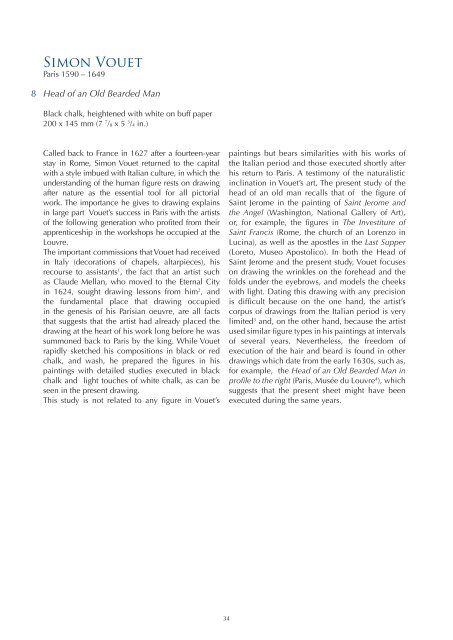Works on Paper 2019 - Jean Luc Baroni
- No tags were found...
Create successful ePaper yourself
Turn your PDF publications into a flip-book with our unique Google optimized e-Paper software.
Sim<strong>on</strong> Vouet<br />
Paris 1590 – 1649<br />
8<br />
Head of an Old Bearded Man<br />
Black chalk, heightened with white <strong>on</strong> buff paper<br />
200 x 145 mm (7 7 /8 x 5 3 /4 in.)<br />
Called back to France in 1627 after a fourteen-year<br />
stay in Rome, Sim<strong>on</strong> Vouet returned to the capital<br />
with a style imbued with Italian culture, in which the<br />
understanding of the human figure rests <strong>on</strong> drawing<br />
after nature as the essential tool for all pictorial<br />
work. The importance he gives to drawing explains<br />
in large part Vouet’s success in Paris with the artists<br />
of the following generati<strong>on</strong> who profited from their<br />
apprenticeship in the workshops he occupied at the<br />
Louvre.<br />
The important commissi<strong>on</strong>s that Vouet had received<br />
in Italy (decorati<strong>on</strong>s of chapels, altarpieces), his<br />
recourse to assistants 1 , the fact that an artist such<br />
as Claude Mellan, who moved to the Eternal City<br />
in 1624, sought drawing less<strong>on</strong>s from him 2 , and<br />
the fundamental place that drawing occupied<br />
in the genesis of his Parisian oeuvre, are all facts<br />
that suggests that the artist had already placed the<br />
drawing at the heart of his work l<strong>on</strong>g before he was<br />
summ<strong>on</strong>ed back to Paris by the king. While Vouet<br />
rapidly sketched his compositi<strong>on</strong>s in black or red<br />
chalk, and wash, he prepared the figures in his<br />
paintings with detailed studies executed in black<br />
chalk and light touches of white chalk, as can be<br />
seen in the present drawing.<br />
This study is not related to any figure in Vouet’s<br />
paintings but bears similarities with his works of<br />
the Italian period and those executed shortly after<br />
his return to Paris. A testim<strong>on</strong>y of the naturalistic<br />
inclinati<strong>on</strong> in Vouet’s art, The present study of the<br />
head of an old man recalls that of the figure of<br />
Saint Jerome in the painting of Saint Jerome and<br />
the Angel (Washingt<strong>on</strong>, Nati<strong>on</strong>al Gallery of Art),<br />
or, for example, the figures in The Investiture of<br />
Saint Francis (Rome, the church of an Lorenzo in<br />
<strong>Luc</strong>ina), as well as the apostles in the Last Supper<br />
(Loreto, Museo Apostolico). In both the Head of<br />
Saint Jerome and the present study, Vouet focuses<br />
<strong>on</strong> drawing the wrinkles <strong>on</strong> the forehead and the<br />
folds under the eyebrows, and models the cheeks<br />
with light. Dating this drawing with any precisi<strong>on</strong><br />
is difficult because <strong>on</strong> the <strong>on</strong>e hand, the artist’s<br />
corpus of drawings from the Italian period is very<br />
limited 3 and, <strong>on</strong> the other hand, because the artist<br />
used similar figure types in his paintings at intervals<br />
of several years. Nevertheless, the freedom of<br />
executi<strong>on</strong> of the hair and beard is found in other<br />
drawings which date from the early 1630s, such as,<br />
for example, the Head of an Old Bearded Man in<br />
profile to the right (Paris, Musée du Louvre 4 ), which<br />
suggests that the present sheet might have been<br />
executed during the same years.<br />
34
















